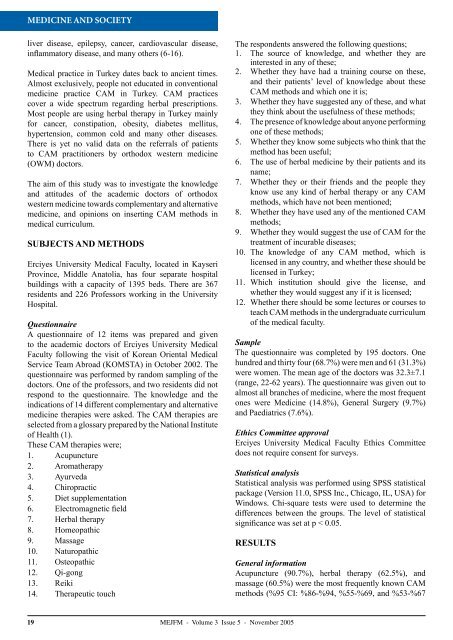Contents - Middle East Journal of Family Medicine
Contents - Middle East Journal of Family Medicine
Contents - Middle East Journal of Family Medicine
Create successful ePaper yourself
Turn your PDF publications into a flip-book with our unique Google optimized e-Paper software.
MEDICINE AND SOCIETY<br />
liver disease, epilepsy, cancer, cardiovascular disease,<br />
inflammatory disease, and many others (6-16).<br />
Medical practice in Turkey dates back to ancient times.<br />
Almost exclusively, people not educated in conventional<br />
medicine practice CAM in Turkey. CAM practices<br />
cover a wide spectrum regarding herbal prescriptions.<br />
Most people are using herbal therapy in Turkey mainly<br />
for cancer, constipation, obesity, diabetes mellitus,<br />
hypertension, common cold and many other diseases.<br />
There is yet no valid data on the referrals <strong>of</strong> patients<br />
to CAM practitioners by orthodox western medicine<br />
(OWM) doctors.<br />
The aim <strong>of</strong> this study was to investigate the knowledge<br />
and attitudes <strong>of</strong> the academic doctors <strong>of</strong> orthodox<br />
western medicine towards complementary and alternative<br />
medicine, and opinions on inserting CAM methods in<br />
medical curriculum.<br />
SUBJECTS AND METHODS<br />
Erciyes University Medical Faculty, located in Kayseri<br />
Province, <strong>Middle</strong> Anatolia, has four separate hospital<br />
buildings with a capacity <strong>of</strong> 1395 beds. There are 367<br />
residents and 226 Pr<strong>of</strong>essors working in the University<br />
Hospital.<br />
Questionnaire<br />
A questionnaire <strong>of</strong> 12 items was prepared and given<br />
to the academic doctors <strong>of</strong> Erciyes University Medical<br />
Faculty following the visit <strong>of</strong> Korean Oriental Medical<br />
Service Team Abroad (KOMSTA) in October 2002. The<br />
questionnaire was performed by random sampling <strong>of</strong> the<br />
doctors. One <strong>of</strong> the pr<strong>of</strong>essors, and two residents did not<br />
respond to the questionnaire. The knowledge and the<br />
indications <strong>of</strong> 14 different complementary and alternative<br />
medicine therapies were asked. The CAM therapies are<br />
selected from a glossary prepared by the National Institute<br />
<strong>of</strong> Health (1).<br />
These CAM therapies were;<br />
1. Acupuncture<br />
2. Aromatherapy<br />
3. Ayurveda<br />
4. Chiropractic<br />
5. Diet supplementation<br />
6. Electromagnetic field<br />
7. Herbal therapy<br />
8. Homeopathic<br />
9. Massage<br />
10. Naturopathic<br />
11. Osteopathic<br />
12. Qi-gong<br />
13. Reiki<br />
14. Therapeutic touch<br />
The respondents answered the following questions;<br />
1. The source <strong>of</strong> knowledge, and whether they are<br />
interested in any <strong>of</strong> these;<br />
2. Whether they have had a training course on these,<br />
and their patients’ level <strong>of</strong> knowledge about these<br />
CAM methods and which one it is;<br />
3. Whether they have suggested any <strong>of</strong> these, and what<br />
they think about the usefulness <strong>of</strong> these methods;<br />
4. The presence <strong>of</strong> knowledge about anyone performing<br />
one <strong>of</strong> these methods;<br />
5. Whether they know some subjects who think that the<br />
method has been useful;<br />
6. The use <strong>of</strong> herbal medicine by their patients and its<br />
name;<br />
7. Whether they or their friends and the people they<br />
know use any kind <strong>of</strong> herbal therapy or any CAM<br />
methods, which have not been mentioned;<br />
8. Whether they have used any <strong>of</strong> the mentioned CAM<br />
methods;<br />
9. Whether they would suggest the use <strong>of</strong> CAM for the<br />
treatment <strong>of</strong> incurable diseases;<br />
10. The knowledge <strong>of</strong> any CAM method, which is<br />
licensed in any country, and whether these should be<br />
licensed in Turkey;<br />
11. Which institution should give the license, and<br />
whether they would suggest any if it is licensed;<br />
12. Whether there should be some lectures or courses to<br />
teach CAM methods in the undergraduate curriculum<br />
<strong>of</strong> the medical faculty.<br />
Sample<br />
The questionnaire was completed by 195 doctors. One<br />
hundred and thirty four (68.7%) were men and 61 (31.3%)<br />
were women. The mean age <strong>of</strong> the doctors was 32.3±7.1<br />
(range, 22-62 years). The questionnaire was given out to<br />
almost all branches <strong>of</strong> medicine, where the most frequent<br />
ones were <strong>Medicine</strong> (14.8%), General Surgery (9.7%)<br />
and Paediatrics (7.6%).<br />
Ethics Committee approval<br />
Erciyes University Medical Faculty Ethics Committee<br />
does not require consent for surveys.<br />
Statistical analysis<br />
Statistical analysis was performed using SPSS statistical<br />
package (Version 11.0, SPSS Inc., Chicago, IL, USA) for<br />
Windows. Chi-square tests were used to determine the<br />
differences between the groups. The level <strong>of</strong> statistical<br />
significance was set at p < 0.05.<br />
RESULTS<br />
General information<br />
Acupuncture (90.7%), herbal therapy (62.5%), and<br />
massage (60.5%) were the most frequently known CAM<br />
methods (%95 CI: %86-%94, %55-%69, and %53-%67<br />
19<br />
MEJFM - Volume 3 Issue 5 - November 2005
















